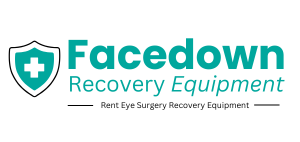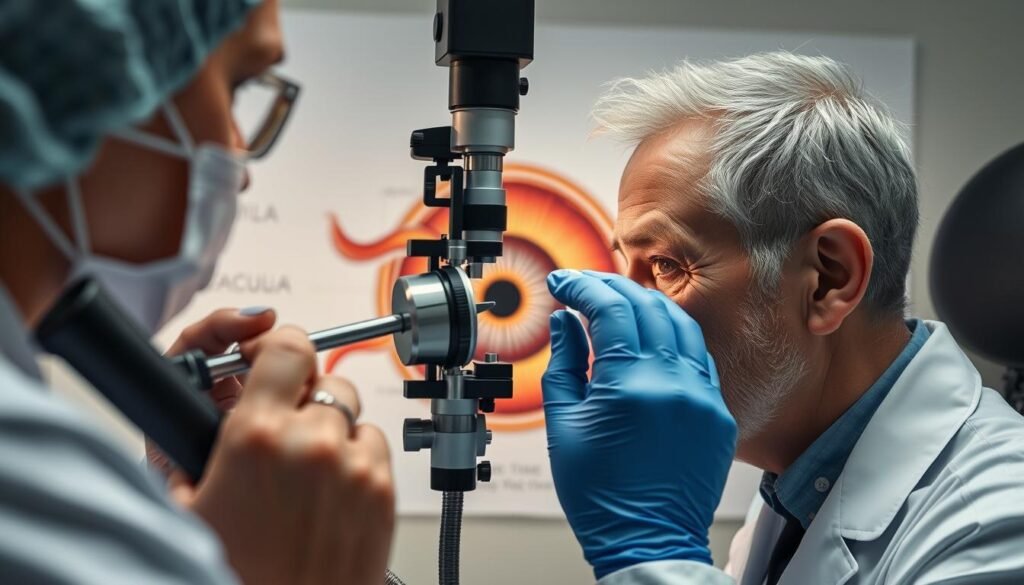Imagine a world where a single surgery can bring back your sight and freedom. For those with macular holes, this dream is real. But knowing the success rates and care after surgery is key for the best results.
In this guide, we’ll explore how macular holes form and the latest in surgery. We’ll also cover important steps for a smooth recovery and better vision. This article is for those newly diagnosed or looking to learn more about eye health.
Key Takeaways
- Understand the common causes and symptoms of macular holes to recognize the problem early
- Discover the current success rates of macular hole surgery and how it can improve your vision
- Learn essential recovery guidelines, including face-down positioning and activity restrictions, to maximize your results
- Explore innovative surgical techniques and their impact on post-operative outcomes
- Manage post-surgery complications and know when to contact your surgeon for support
Understanding Macular Hole Formation and Its Impact on Vision
Macular holes are a common eye problem that can greatly affect your vision. These small openings in the retina’s center, called the macula, can cause blurry and distorted vision. Knowing the causes, symptoms, and risk factors is key to getting the right retinal repair and ophthalmological guidance.
Common Causes of Macular Holes
Macular holes often happen when the gel in your eye changes. As you get older, this gel can shrink and pull away from the retina. This can cause a hole in the macula. Eye injuries, previous surgeries, and conditions like diabetes or high myopia can also cause them.
Symptoms and Early Detection
The main sign of a macular hole is a decrease in central vision. You might see things as blurry or have a blind spot in the middle. Finding it early is important. Quick post-operative eye care can help fix the hole better.
Risk Factors to Consider
- Age: Macular holes are more common in older adults, with the risk increasing after the age of 60.
- Gender: Women are slightly more prone to developing macular holes than men.
- Myopia: High levels of nearsightedness (myopia) can increase the risk of macular hole formation.
- Eye Injury: Trauma or injury to the eye can lead to the development of a macular hole.
- Certain Medical Conditions: Diseases like diabetes, high blood pressure, and eye disorders can contribute to macular hole formation.
Knowing about macular holes is the first step to getting the right treatment. Seeing an ophthalmologist is key for diagnosing and managing this condition. This ensures the best results for your vision.
Current Success Rates in Macular Hole Surgery
Medical technology has made big strides in macular hole surgery success. Today, patients see great results in macular hole recovery, vision restoration, and retinal repair. Let’s look at the current success rates and what makes them so good.
Recent studies show a 90% success rate for macular hole surgery. This means 9 out of 10 patients see their vision improve. When caught early, the success rate jumps to 95%.
- Advances in Surgery: New surgical methods, like using small tools and gentle handling, have boosted success rates. Surgeons can now fix the root causes of macular holes more effectively.
- Surgeon’s Skill: The surgeon’s experience is crucial for a successful surgery. Patients should look for ophthalmologists with a strong track record in vitreoretinal surgery.
- Acting Fast: Early detection and quick surgery are vital for success. The sooner the surgery, the better the vision recovery and less damage.
As ophthalmology keeps advancing, we expect even better success rates in macular hole surgery. This brings hope and better lives for those with this condition.
Post-surgery Tips for Macular Hole Patients
Recovering from macular hole surgery needs patience and care. The right post-operative care can help avoid complications and improve your results. Here are some key tips to help you through the recovery:
Essential Recovery Guidelines
It’s important to follow your surgeon’s advice during recovery. This means sticking to your medication schedule, going to follow-up appointments, and making lifestyle changes to aid healing. Keep your area clean, avoid hard work, and rest a lot to help your eye heal.
Face-down Positioning Requirements
Face-down positioning is a key part of healing from a macular hole. Your doctor will tell you to stay in this position for many hours a day. This helps the gas or oil bubble used to close the hole stay in place. It’s crucial to follow this advice for the best healing.
Activity Restrictions During Recovery
- Avoid bending, lifting, or straining, as these actions can disrupt the delicate positioning of the gas or oil bubble.
- Limit your physical activity and refrain from strenuous exercise until your surgeon clears you to resume normal activities.
- Be cautious when sleeping and consider using a specially designed face-down positioning device to maintain the proper posture.
By following these tips, you can reduce complications, heal faster, and get the best vision from your surgery. Always talk to your eye care team for specific advice and support during your recovery.
| Tip | Description |
|---|---|
| Essential Recovery Guidelines | Follow your surgeon’s instructions, maintain good hygiene, avoid strenuous activities, and prioritize rest. |
| Face-down Positioning Requirements | Remain in a face-down position for an extended period to ensure proper positioning of the gas or oil bubble. |
| Activity Restrictions During Recovery | Avoid bending, lifting, or straining, and limit physical activity until cleared by your surgeon. |
Innovative Surgical Techniques and Their Outcomes
Ophthalmologists are always looking to improve macular hole repair. They aim to increase success rates and help patients see better. New techniques have led to big improvements in retinal repair.
One new method is using the patient’s own RPE cells. This involves taking a small part of the patient’s RPE cells and putting them in the macular hole. It helps fix the hole and improve vision. Studies show this method can close holes up to 90% of the time, with big improvements in vision.
Another new idea is using special tissue sealants and adhesives. These materials help keep the retinal flap in place during surgery. Early results show they can close holes over 85% of the time. This is good news for tough cases.
| Surgical Technique | Closure Rate | Visual Acuity Improvement |
|---|---|---|
| Autologous RPE Transplantation | Up to 90% | Significant |
| Tissue Sealants and Adhesives | Over 85% | Moderate to Significant |
| Traditional Macular Hole Surgery | 70-90% | Moderate |
Even though traditional surgery is still effective, new methods offer more hope. These new techniques give doctors more options for fixing macular holes. This means better care for patients and a chance for them to see better.
Recovery Timeline and Vision Restoration Expectations
The journey to better vision after a macular hole repair surgery has a clear plan. Knowing the short-term goals and long-term vision improvements helps. It lets you understand what to expect and get ready for follow-up care.
Short-term Recovery Milestones
In the first weeks after surgery, your vision will start to get better. You can look forward to:
- Clearer central vision in the first few days
- Less blurriness and distortion in the first two weeks
- Less sensitivity to light and less glare in the first month
Long-term Vision Improvement Patterns
After the initial recovery, your vision will keep getting better. Over several months, you might see:
- Sharper details and better contrast
- Better depth perception and more vibrant colors
- Less blind spots or distortion in your central vision
Follow-up Care Schedule
Seeing your ophthalmologist regularly is key during macular hole recovery. They will check on your vision restoration and help with post-operative eye care. You can expect:
| Timeline | Examination |
|---|---|
| 1-2 weeks | Suture removal and visual acuity assessment |
| 1 month | Comprehensive eye exam and progress evaluation |
| 3-6 months | Monitoring of long-term vision improvement |
Knowing the recovery timeline, vision restoration, and follow-up care helps. It lets you face your surgery with confidence. You can work with your healthcare team for the best vision outcomes.
Essential Equipment for Post-operative Recovery
After surgery for a macular hole, having the right equipment is key. FacedownRecoveryEquipment.com provides a wide range of tools to help your recovery. They ensure you have everything needed for a smooth healing process.
A face-down positioning device is a must-have. This chair or frame keeps your head in the right position. It helps prevent complications and aids in healing.
| Equipment | Purpose | Importance |
|---|---|---|
| Face-down Positioning Device | Maintains proper head and eye position during recovery | Crucial for healing the macular hole and preventing further complications |
| Protective Eye Shields | Shields the eye from accidental impact or touch during recovery | Safeguards the delicate surgical area and supports the healing process |
| Supportive Pillows and Cushions | Provides comfort and stability while in the face-down position | Enhances patient comfort and helps maintain the necessary posture |
FacedownRecoveryEquipment.com has a vast selection of top-notch equipment for macular hole patients. Their team can help you choose the right tools. They ensure a successful recovery experience.
Following your surgeon’s advice and using the right equipment is vital. By choosing the right tools from FacedownRecoveryEquipment.com, you can aid in healing. This increases your chances of improving your vision.
Managing Post-Surgery Complications
After macular hole repair surgery, knowing about possible complications is key. It’s also important to know when to get help from an eye doctor. Taking care of these issues early can help you recover smoothly.
Common Side Effects
Some common side effects after surgery include minor discomfort, redness, or swelling in the eye. These usually go away in a few days to weeks with good post-operative eye care.
Warning Signs to Watch For
- Sudden increase in pain or discomfort
- Significant redness, swelling, or discharge from the eye
- Sudden vision changes or loss of vision
- Persistent headaches or dizziness
When to Contact Your Surgeon
If you notice any warning signs, contact your surgeon right away. Quick ophthalmological guidance can help fix any problems. This can prevent more vision loss or other issues.
| Potential Complications | Recommended Action |
|---|---|
| Increased eye pressure (intraocular pressure) | Notify your surgeon, as they may need to adjust your eye drops or other treatment |
| Recurrence of the macular hole | Schedule a follow-up appointment for evaluation and potential additional treatment |
| Retinal detachment | Seek immediate medical attention, as this is a serious condition that requires prompt treatment |
Being proactive with post-operative eye care and talking openly with your ophthalmologist is crucial. This can help avoid complications and improve your vision after surgery.
The Role of Professional Support and Equipment Rental
Recovering from macular hole surgery is tough. That’s why you need professional help and the right gear. FacedownRecoveryEquipment.com gets it. They offer the tools and advice you need for a good recovery.
FacedownRecoveryEquipment.com Services
FacedownRecoveryEquipment.com has services just for macular hole patients after surgery. They rent out special recovery equipment and offer consultations with experts. They aim to make your recovery comfortable and smooth.
Equipment Delivery and Setup Process
Our team will figure out what you need and bring the equipment to your home. They know setting it up right is key. They’ll help you set up your recovery space for your health and vision.

